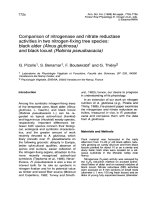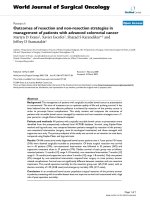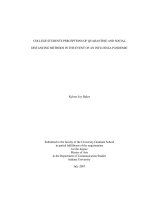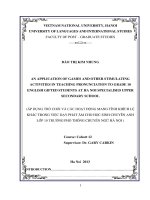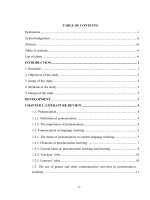Twelfth graders’ perceptions of communicative and non communicative activities in EFL classes in Bac Ly High School
Bạn đang xem bản rút gọn của tài liệu. Xem và tải ngay bản đầy đủ của tài liệu tại đây (1.12 MB, 18 trang )
Twelfth graders’ perceptions of communicative
and non communicative activities in EFL
classes in Bac Ly High School
Nguyễn Thị Thu Hương
Trường Đại học KHXH&NV
Luận văn ThS. Chuyên ngành: English Teaching Methodology; Mã số: 60 14 10
Người hướng dẫn: Dr. Tô Thị Thu Hương
Năm bảo vệ: 2011
Abstract: This study investigates the perceptions of 200 twelfth grade students in order
to better understand the appropriateness and effectiveness of communicative and non-
communicative activities in their English as a Foreign Language classes in Bac Ly high
school. Using mixed methods, data were collected by means of a questionnaire, semi-
structured interview and group discussion. Quantitative data complement qualitative data
to provide more valid and reliable results. The research reveals that the majority of the
students expressed strong interest in non-communicative activities rather than
communicative activities in term of preference and usefulness. Perceptions of these
students sometimes surprised their teachers, and that the learners’ perceived difficulties in
taking part in communicative activities had their source in learners’ low proficiency, low
motivation for communicative competence, traditional learning styles and habits, and
EFL settings. Recommendations for overcoming these difficulties including a need for
closer co-operation between students and teachers in the way, which helps students
develop their communicative competence, are made to the study.
Keywords: Tiếng Anh; Giao tiếp; Phi giao tiếp; Phổ thông trung học
iv
TABLE OF CONTENTS
page
DECLARATION OF ORIGINALITY i
ACKNOWLEDGEMENTS ii
ABSTRACT iii
TABLE OF CONTENTS iv
LIST OF ABBREVIATIONS vi
LIST OF TABLES AND CHARTS vii
PART A: INTRODUCTION
1. Rationale of the study 1
2. Aims and Objectives of the study 2
3. Research Questions 2
4. Scope of the study 2
5. Methods of the study 3
6. Significance of the study 3
7. Structure of the study 4
PART B: DEVELOPMENT
CHAPTER 1: LITERATURE REVIEW
1.1 Theoretical background of Communicative Language Teaching (CLT) 6
1.1.1 Definitions of CLT 6
1.1.2 Characteristics of communicative language teaching 7
1.2 Communicative and non-communicative activities in language teaching
and learning process 8
1.2.1 Definition of communicative and non-communicative activities 8
1.2.2 Characteristics of communicative and non-communicative activities 9
1.2.3 Roles of communicative activities in language teaching and learning 10
1.2.4 The roles of teachers in communicative activities 11
1.2.5 Types of communicative activities 12
v
1.3 Students’ perceptions of communicative and non-communicative
activities 14
1.4 Summary 15
CHAPTER 2: METHODOLOGY
2.1 Research approach 17
2.2 Research setting 17
2.3 Subjects 17
2.4 The Textbook English 12 19
2.5 Data collection instruments 20
2.6 Procedures of data collection 21
2.7 Procedures of data analysis 22
CHAPTER 3: RESULTS AND DISCUSSION
3.1 Students’ perceptions of communicative and non-communicative activities 23
3.1.1 Students’ preference of communicative and non-communicative
activities 23
3.1.2 Students’ opinions of the usefulness of these activities 27
3.2 Students’ perceived difficulties in practicing communicative activities 29
3.2.1 Low English proficiency 29
3.2.2 Traditional learning styles and habits 30
3.2.3 Little motivation for communicative competence 31
3.2.4 EFL settings 31
CHAPTER 4: IMPLICATIONS AND RECOMMENDATIONS
4.1 To MOET, DOET 33
4.2 To teachers 34
4.3 To students 37
PART C: CONCLUSION 38
REFERENCES 40
APPENDICES I
PART A- THE INTRODUCTION
1. Rationale of the study
The field of second or foreign language teaching has undergone many paradigmatic
shifts and methodological trends over the last few decades. We have seen the Audiolingual
Method, Cognitive-based Approaches, the Total Physical Response, the Natural Approach,
Communicative Language Teaching and many others. Within the debate on English
teaching methodology, the study of Vietnamese students’ response to CLT, especially
classroom activities deserves particular attention. Do they enjoy activities involving
communication and real use of language? Do they agree that real language activities
emphasizing language content are more effective than non-communicative activities that
stress formal correction? Do they believe that such activities are helpful to them as
language learners? Do they face with any difficulties in practicing these activities?
According to Kumaravadivelu (1991, p. 107) "the more we know about the
learner's personal approaches and personal concepts, the better and more productive our
interactions will be." We as teachers should be aware of our students' perceptions and
beliefs about language learning in order to facilitate desired learning outcomes in the
classroom. As suggested by Bada and Okan (2000), there is a need for closer cooperation
between students and teachers. It is important to remember that learners already critically
evaluate what they do (Breen, 1989). Teachers can use different strategies to build learners
choices into their lessons. Teachers and students can have a dialogue and negotiate
alternatives, which would definitely lead to more learner involvement and could, therefore,
lead to more positive attitudes towards language learning. As teachers, at every single
moment, we should observe our students' reactions and consider their attitudes and
preferences in order to promote a more inclusive climate that will enhance learning. In
order to deepen our understanding of how students react to communicative and non-
communicative activities, Barkhuisen (1998:86) has called for “teachers to discover their
learners’ feelings and beliefs about their language learning experiences and consequently
to review and possibly change their teaching process”.
Moreover, Vietnamese high school syllabi now keep promoting CLT in an attempt
to enable the students to use the target language for communicative purposes instead of
mastering its grammatical rules and structures. Vietnamese twelfth graders in upper
secondary school had five-year experience studying English “communicatively” as English
is among the compulsory subjects at secondary schools. However, the fact is that after
those years of learning English, not many pupils have a clear cut purpose of learning
English in their mind and they are likely passively motivated to learn English basing on
the textbooks and teachers’ method of delivery. Consequently, most of pupils find
themselves unable to use English for day-to-day communication after having passed the
English national examination as a requirement for the General Education Diploma.
In brief, all of the reasons mentioned above have inspired the present study on:
“Twelfth graders’ perceptions of communicative and non-communicative activities in
EFL classrooms in Bac Ly high school” as the title for the thesis in the hope that I can
contribute a small part in helping my students and my colleagues to improve their learning
and teaching English.
2. Aims and objectives of the study
With the above-presented rationales, the specific aims and objectives of the study
are the followings. Firstly, the study carries out an investigation into twelfth grade
students’ perceptions of communicative and non-communicative activities in terms of
preference and usefulness. Secondly, through the investigation the research will find out
the difficulties the students encounter in practicing communicative activities. Thirdly, the
study will provide possible solutions to these difficulties, thereby improving the quality of
English language education in the context of an urban high school.
3. Research Questions
1. What are twelfth graders’ perceptions of communicative and non-communicative
activities in the EFL classrooms?
2. What are students’ perceived difficulties in practicing communicative activities?
3. What are the possible solutions to these difficulties?
4. Scope of the study
Due to time constraint, the study limits itself to the investigation on twelfth graders’
perceptions of non-communicative and communicative activities in EFL classroom in the
context of an urban high school, Bac Ly high school. Therefore, subjects of the study were
teachers of English and students in the twelfth form at Bac Ly high school in Ha Nam
province. Within the scope of the study, the following issues were addressed:
- Students’ preference of communicative and non-communicative activities
(Research question 1)
- Students’ opinions of the usefulness of communicative and non-communicative
activities (Research question 1)
- Students’ difficulties in participating in communicative activities (Research
question 2)
- Implications and recommendations for overcoming these difficulties (Research
question 3)
5. Methods of study
In this study, a mix of quantitative and qualitative methods were utilized. A
questionnaire survey was conducted on a sample of students to find answers to research
questions 1 and 2. Furthermore, in order to address the limitations of the questionnaire in
exploring students’ perceptions, and to find out their constraints and possible solutions
(research questions 3), student semi-structured interviews and teacher group discussions
were conducted following the analysis of the questionnaire data. Questionnaire data
were analyzed quantitatively for descriptive statistics while the interview and discussion
data were processed qualitatively following an “interpretive model” (Hatch 2002) for
recommended solutions. The answers to three research questions provided a picture of
students’ perceptions of communicative and non-communicative activities as well as their
difficulties in doing communicative activities in EFL classrooms and possible solutions.
6. Significance of the study
English is used more and more to communicative throughout the world. MOET have
provided a series of new textbooks in order to develop students’ communicative
competence. It is said that the textbooks are more useful than the older version, but most of
students hardly communicate in English after graduating from high schools and that
teachers and authors should adapt and revise these books. In such a circumstance, the
findings will hopefully aid teachers in their choice of classroom activities and in deciding
how learning activities should be arranged and implemented in the classroom while
waiting for MOET to make some changes in these books.
Although the study is intended to investigate students’ perceptions of non-
communicative and communicative activities in EFL classrooms in an urban high school,
which is not researched adequately in the context of Ha Nam-based high schools, the
outcome of the study can contribute significantly to our understanding of the issue in high
schools with a similar context. As such, this study will serve as a reference material not
only for teachers of English in Bac Ly high school but also for teachers elsewhere who
wish to continually improve the quality of teaching and learning English.
7. Structure of the Thesis
This paper is divided into three main parts:
Part A is the INTRODUCTION. In this part, the rationales of the study, the aims,
research questions, the scope of the study, methods of the study and also its design are
presented.
Part B is the DEVELOPMENT which includes 4 chapters.
Chapter I, Literature Review, deals with a theoretical background about the
definitions of CLT and its characteristics; definitions, characteristics, roles, types of
communicative and non-communicative activities in the process of learning and teaching;
the roles of the teacher in communicative and non-communicative types of communicative
activities, and previous studies on students’ perceptions about classroom activities.
Chapter II, Research Methodology, describes the situation where the study was
conducted and the informants involved in the study. It includes the teachers of English, the
students, and the textbook. The data collection instruments, procedures of data collection
and data analysis were also presented in this chapter.
Chapter III, Results and Discussion, presents and discusses the results finding
out the students’ perceptions of communicative and non-communicative activities and their
difficulties in participating in communicative activities.
Chapter IV, Implications and Recommendations, presents some pedagogical
implications of the study and suggestions for overcoming difficulties in practicing
communicative activities in the way, which helps students develop their communicative
competence in Bac Ly high school.
Part C is the CONCLUSION which summarizes the main points of the study, limitations
and suggests for further research.
REFERENCES and APPENDICES are presented in the last pages of the study.
PART B DEVELOPMENT
CHAPTER I: LITERATURE REVIEW
This chapter reviews the literature on Communicative Language Teaching (CLT), and
previous studies on students’ perceptions of non-communicative and communicative
activities. First, it presents definitions and the main characteristics of CLT that is followed
by a discussion of con-communicative and communicative activities in language teaching
and learning process. Finally, it presents previous studies on students’ perceptions of non-
communicative and communicative activities.
1.1. Theoretical background of Communicative Language Teaching (CLT)
1.1.1. Definitions of CLT
1.1.2. Characteristics of communicative language teaching
1.2. Communicative and non-communicative activities in language teaching and
learning process
1.2.1. Definition of communicative activities and non-communicative activities
1.2.2 Characteristics of communicative and non-communicative activities
1.2.3 The roles of communicative and non-communicative activities in language
teaching and learning
1.2.4 The roles of teachers in communicative and non-communicative activities
1.2.5 Types of communicative activities
1.3. Students’ perceptions of non-communicative and communicative activities
1.4. Summary
In this chapter, the researcher tried to provide a brief description of the theoretical
knowledge relating to the study. Included are CLT and its characteristics. Most of the
linguistics agree that CLT is directly connected to developing communicative competence
and its characteristics will be the principles for teachers to choose appropriate techniques
as well as activities in class to improve the students’ communicative competence. This
chapter also included a discussion of communicative and non-communicative activities in
language teaching and learning. Definitions, characteristics, roles are discussed in order
that distinguishing the characteristics and roles of these activities can make the best use of
communicative and non-communicative activities in the process of learning and teaching.
The role of the teacher in communicative and non-communicative activities is also
mentioned in order to point out teacher’s importance in organizing classroom activities.
Moreover, types of communicative activities are grouped according to the classification of
Littlewood (1981). Other previous studies on students’ perceptions about classroom
activities which have suggested that the dominant trend among learners is a preference for
non-communicative activities.
In this study, the combination of Harmer’s (1981) six distinctive characteristics and
Littlewood’s (1981) classification of classroom activities is used as the methodological
framework for data analysis. Harmer’s (1981) six distinctive characteristics of
communicative and non-communicative activities are used as criteria to distinguish these
two kinds of activities. In addition, Littlewood’s (1981) classification of classroom
activities is taken as a gauge for communicative classroom procedures, which is the
continuum of pre-communicative and communicative activities. Furthermore, the term
“non-communicative activities” of Harmer’s (1981) is considered as “pre-communicative
activities” in Littlewood’s (1981).
CHAPTER TWO: METHODOLOGY
In this chapter, the writer provides some information about research approach, the basic
settings for the study. The following section describes in details how the data for the
research were collected and analyzed to answer the three questions set for this research,
namely:
1. What are twelfth graders’ perceptions of communicative and non-communicative
activities in the EFL classrooms?
2. What are students’ perceived difficulties in practicing communicative activities?
3. What are the possible solutions to these difficulties?
2.1. Research Approach
2.2. Research setting
2.3. Subjects
2.3.1. Selection of subjects:
2.3.2. Students
2.3.3. Teachers
2.4. The Textbook English 12
2.5. Research instruments:
2.5.1. Survey Questionnaire
2.5.2. Semi-structured Interviews
2.5.3. Group Discussions
2.6. Procedures of data collection:
In the beginning of the second semester, the researcher issued questionnaire to 200
students and received the 200 answered questionnaires back at the same day. The
respondents were also required to indicate their position in the class list in order to
guarantee that the chosen samples truly reflected the random sampling procedure. All
students returned the questionnaire. Information from the questionnaire was then
summarized and presented in the form of statistic information (tables and charts) for
analysis to make implications and recommendations on the most applicable ways to
develop communicative competence for students.
After analyzing the questionnaire, the researcher chose randomly 15 students in the
sample for interviews. After that, group discussions with eight teachers of English were
made to ensure validity and reliability of the collected data. All interviews and group
discussions were audio taped and transcribed. The transcripts of discussions were later
given to the subjects for verification.
2.7. Procedures of data analysis:
The data collected were both quantitative and qualitative ones as they could throw
light on the insights of each other (Wallace, 1998, p.38) to help answer the three research
questions set for the study. For qualitative analysis, text rendering was used. For
quantitative analysis, tables, percentage, charts were produced. Interpretations were then
made with regards to the research questions. The framework for analysis of collected data,
thus, is made up of three themes. They are:
- The students’ perceptions of communicative and non-communicative activities
Students’ preference of communicative and non-communicative activities
Students’ opinions of the usefulness of these activities
- Students’ perceived difficulties in practicing communicative activities
Low English proficiency
Little motivation for communicative competence
Traditional learning styles and habits
EFL settings
- Possible solutions to help students overcome these difficulties, thereby improving the
quality of English language education
By reading through the completed questionnaire and the interview and discussion
transcripts over and over again, I discovered the students’ perceptions of communicative
and non-communicative activities and identified difficulties that students had encountered
in taking part in communicative activities.
CHAPTER THREE: RESULTS AND DISCUSSION
This chapter presents the findings and discussions of the study.
3.1. The students’ perceptions of communicative and non-communicative activities in
the EFL classroom
3.1.1. Students’ preference of communicative and non-communicative activities
All the 200 subjects showed interest in the methods their teacher used in the
English classroom. The survey results suggest that the students favored a variety of
classroom activities, but that they liked non-communicative activities more than
communicative ones as in table 1 and table 2.
After making group discussions with teachers on their perceptions of students’
preferences, the results indicate that, in non-communicative activities, there is a significant
difference between students’ preferences and teachers’ perception of those preferences. It
conveys that students’ preferences for non-communicative activities were significantly
higher than their teachers’ beliefs and that teachers are not highly aware of students’
preferences in this regard. Some activities which were given very high priority by students
such as pronunciation practice and error correction were marked low by teachers. There is
no significant difference between students and teachers for communicative activities,
which implies that in contrast with non-communicative activities, in communicative
activities, the instructors are more aware of their students’ preferences.
3.1.2. Students’ opinions of the usefulness of communicative and non-communicative
activities
Students thought that just some communicative activities are useful to their
language learning outcome, all non-communicative activities are helpful for their current
learning situation. In non-communicative activities, ten out of ten items were claimed to be
important by more than two thirds, while of ten communicative activities, seven were
thought to be useful by most students.
The result indicates that most of students were aware of the usefulness of classroom
activities. This was not considered as a surprise to their teachers. When asking teachers if
which communicative activities or non-communicative activities their students think are
helpful to their language learning, all teachers reached an agreement of non-
communicative activities. According to them, the main reason for their opinions was their
difficulties in taking part in communicative activities. These difficulties prevent them from
realizing the enjoyment and the usefulness of communicative activities in EFL classrooms.
3.2. Students’ perceived difficulties in practicing communicative activities
To meet their current needs in English learning, all the subjects unanimously
agreed that a combination of communicative and non-communicative activities was a best
way. However, most of the subjects reported having encountered difficulties caused by
communicative activities. Some of the subjects pointed out that these difficulties made
them unwilling or unable to participate in dynamic classroom activities.
3.2.1. Low English proficiency
3.2.2. Traditional learning styles and habits
3.2.3. Little motivation for communicative competence
3.2.4. EFL settings
CHAPTER 4. IMPLICATIONS AND RECOMMENDATIONS
4.1. Suggestions to MOET, DOET
4.2. To teachers
4.2.1. Balancing the relationship between linguistic competence and communicative
competence
4.2.2. Educating students about classroom activities
4.2.3. Making full use of the textbook and any materials available
4.2.4. Managing speaking turns
4.2.5. Building cooperative atmosphere
4.3. To students
4.3.1. Cooperating with peers
4.3.2. Cooperating with teachers
4.3.3. Taking risks
PART C. CONCLUSION
1. Conclusion on the major findings and discussion
Knowledge of what students think about activities in their language class is very
valuable. It helps teachers and course administrators decide whether and in what directions
the teaching methodologies and/or content need to be improved. Teachers, curriculum
planners, and others who want to be sensitive to the needs of the students they serve cannot
always rely on their unaided intuitions (Rudduck, 1991). By using the present instrument,
in which the students expressed their personal opinions about communicative and non-
communicative activities, the researcher has discovered whether the subjects see certain
kinds of activities as more effective and useful than others. Giving this type of survey to
the students has also helped the researcher identify their difficulties in doing
communicative activities in classroom.
2. Limitations of the study
Although the researcher while conducting the research has made great effort, the
shortcomings and mistakes are inevitable. Due to the limitation of time, in as sense,
anecdotal reflected the perceptions of students of classroom activities in terms of their
preference and usefulness of those activities as well as constraints in participating in
communicative activities. The study did not touch upon the teachers’ perceptions in using
these activities and evaluation of the effectiveness of those activities thoroughly. Despite
all the mentioned limitations, the researcher hopes that this exploratory research will
contribute to the better situation of teaching and learning English at Bac Ly high school.
3. Suggestions for further study
1) This research focused on the students’ perception of communicative and non-
communicative activities in terms of their preference and usefulness as well as difficulties
in doing communicative activities, further studies can focus on writing, reading, listening
or speaking class exclusively.
2) Teachers’ perceptions of communicative and non-communicative activities in EFL
classroom is also considered for further studies.
3) Bridging the gap between learners’ learning needs and expectations and teacher’s
expectation is worth taking into account.
40
REFERENCES
1. Allwright, R. L., & Bailey, K. M. (1991). Focus on the language classroom.
Cambridge: Cambridge University Press.
2. Babbie, E. (1983). The practice of social research (3rd ed.). Belmont, CA: Wadsworth.
3. Bada, E. & Okan, Z. (2000, May). Students' language learning preferences. TESL-EJ,
4(3), 1-15 Retrieved September 2, 2011, from />EJ/ej15/a1.html
4. Barkhuizen, G.P. (1998). Discovering learners' perceptions of ESL classroom
teaching/learning activities in a South African context. TESOL Quarterly, 32, 85-
108.
5. Bates, L.; Lane, J.; Lange, E. (1993) Writing clearly: Responding to ESL compositions.
Boston, MA: Heinle & Heinle.
6. Bechhofer, F. & Paterson, L. (2000). Principles of Research Design in the Social
Sciences. London: Routledge.
7. Breen, M. (1989). The evaluation cycle for language learning tasks. In R. K. Johnson
(Ed.), The second language curriculum (pp.187-206). Cambridge: Cambridge
University Press.
8. Brown, H.D. (2001). Teaching by principles: An interactive approach to language
pedagogy. (2nd ed.). Englewood Cliffs, NJ: Longman.
9. Cohen, L., et al. (2007). Research Methods in Education(6th). London; New York:
Routledge.
10. Celce-Murcia, M. (2001). Teaching English as a Second or Foreign Language 3d.
Boston, MA: Heinle & Heinle.
11. Celce-Murcia, et al. (1995). Communicative Competence: A Pedagogically Motivated
Model With Content Specifications. Issues In Applied Linguistics 6: 5-35.
12. Denzin, N.K., 1989. Interpretive Biography. Sage, Newbury Park, CA.
13. Ferris, D. (2002) Teaching students to self-edit. In: J.C. Richards and W.A. Renandya
(eds.) Methodology in language teaching, Cambridge: Cambridge University
Press.
14. Forseth, R., (1991). Conversation class: how to keep your students talking (in English).
ELIC Teaching 8, 35–44.
41
15. Green, J. (1993). Student Attitudes Toward Communicative and Non-Communicative
Activities: Do enjoyment and effectiveness go together? The Modern Language
Journal, 77: 1-10.
16. Harmer, J. (1981). What is communicative? ELT Journal, 36, 164-168.
17. Harmer, J. (1991). The practice of English language teaching. London: Longman.
18. Horwitz, E. K., & Young, D. J. (1991). Language anxiety. Englewood Cliffs, NJ:
Prentice Hall International.
19. Hymes, D.H. (1971). On communicative competence. Philadelphia: University of
Pennsylvania Press.
20. Kitao, K., 1995. Teaching English through newspapers. In: Kitao, K., Kitao, S.K.
(Eds.), English Teaching: Theory, Research and Practice. Eichosha, Tokyo, pp.
297–320.
21. Kumaravadivelu, B., (1991). Language-learning tasks: teacher in intention and learner
interpretation. ELT Journal 45, 98–107.
22. Lewis, M and McCook, F. (2002). Culture of Teaching: Voices from Vietnam. ELT
Journal, 56/2. Oxford University Press.
23. Lightbown, P. M. & Spada, N. (1999). How languages are learned (2nd ed.). NY:
Oxford University Press.
24. Lindsay, P., & Norman, D. A. (1999). Human information processing: An introduction
to psychology. New York, NY: Academic Press.
25. Littlewood, W. (1981). Communicative Language Teaching: An introduction,
Cambridge England: Cambridge University Press.
26. Littlewood, W., (2000). Do Asian students really want to listen and obey? ELT Journal
54/1, 31–35.
27. Maykut, P., Morehouse, R., (1994). Beginning Qualitative Research. London:The
Falmer Press.
28. Mulling, Sylvia S (1997). Getting to talk: Communicative Activities for the ESOL
Classroom. Kean College of New Jersey.
29. Nguyen Thi Thuy Minh (2007). Textbook evaluation: The case of English textbooks
currently in use in Vietnam’s upper-secondary schools. Singapore: SEAMEO
Regional Center.
30. Nolasco, R. & Arthur, L. (1988). Large Classes. London: Macmillan Publishers.
42
31. Nunan, D. (1987). Communicative language teaching: Making it work. ELT Journal,
41, 136-145.
32. Nunan, D. (1989). Hidden agendas: The role of the learner in programme
implementation In R. K. Johnson (Ed.), The Second Language Curriculum.
Cambridge, Cambridge University Press.
33. Nunan, D. (1991). Language Teaching Methodology. New York: Prentice Hall.
34. Oksana, K. (2006). Students' Perceptions of Classroom Activities. The Case with
German in Australian and Ukrainian. German as a Foreign Language ; No.2,, 20-
46.
35. Phan Le Ha. (2004). University classrooms in Vietnam: contesting the stereotypes, ELT
Journal, 58/1, 50-53, Oxford University Press.
36. Richards, J.C., & Rodgers, T. (2001), Approaches and Methods in Language Teaching.
Cambridge, England : Cambridge University Press.
37. Rudduck, J., (1991). Innovation and Change. Milton Keynes, England: Open University
Press,.
38. Snider, D.(2005). Communicative and Non-Communicative Activities in First-Year
College German Textbooks. Die Unterrichtspraxis / Teaching German, Vol. 38,
No. 2, pp. 163-171.
39. Spratt, M. (1999). How good are we at knowing what learners like. System, 27/2: 141-
55.
40. Swan, M. (2001). Involving students in grammar work: Not too little, not too much. The
Language Teacher, 25(6), 44-45.
41. Thompson, G., (1996). Some misconceptions about communicative language teaching.
ELT Journal 44, 25–37.
42. Tomlinson, B and Bao Dat. (2004). The contribution of Vietnamese learners of English
to ELT methodology. Language Teaching Research, 8/2: 199-222.
43. Tool, D., (1992). Teaching large conversation classes with media aids. English
Teaching Forum 30/2, 32–33.
44. Wallace, M.J. (1998). Why action research? In Action research for language teachers
(pp. 4-19). NY: Cambridge University Press.
45. White, C.J. (1989). Negotiating communicative language learning in a traditional
setting. ELT Journal 43/3, 213–220.
43
46. Yang, A. and Lau, L. (2003) 'Student attitudes to the learning of English at secondary
and tertiary levels'. System 31:107-123.
47. Yang, N. (1998) 'Exploring a new role for teachers: promoting learner autonomy'.
System 26:127-135.




